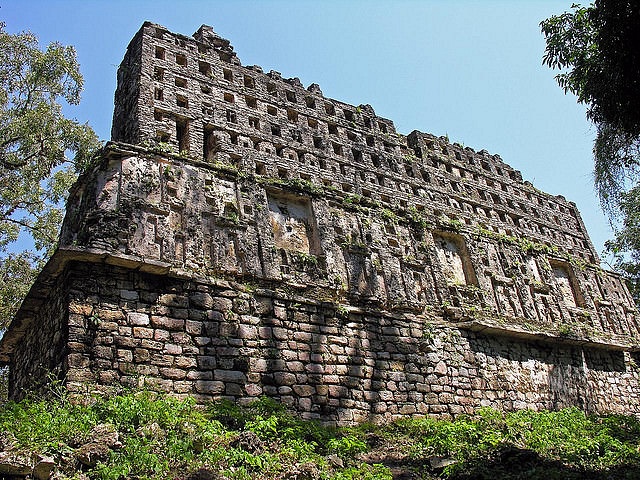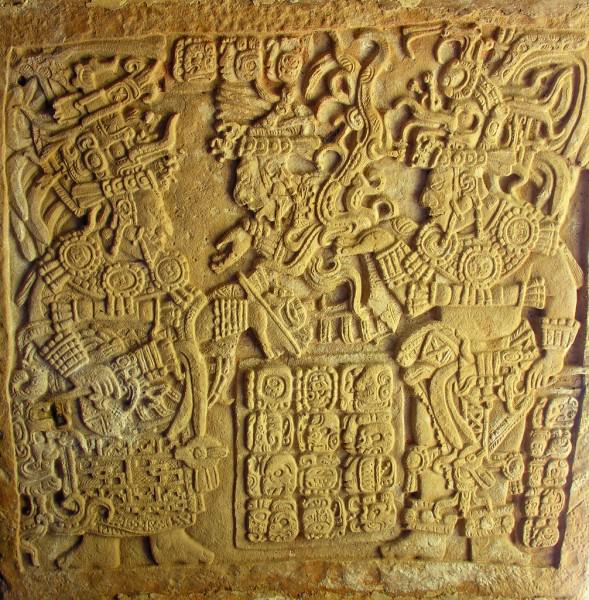Yaxchilan › Cuicuilco » Ancient origins
Articles and Definitions › Contents
- Yaxchilan › Ancient History
- Cuicuilco › Antique Origins
Ancient civilizations › Historical and archaeological sites
Yaxchilan › Ancient History
Definition and Origins

Yaxchilan, located on the banks of the Usumacinta River in the Yucatán peninsula of Mexico, was an important Late Classic Maya centre. The Maya dated the founding of their city to 320 CE, but Yaxchilan flourished between c. 580 and c. 800 CE, benefitting from commerce via the Usumacinta River and trading in copal resin and dyes processed from Brazil wood.Remains of stone pilings suggest the site once had a bridge or toll gate. Impressive in both architecture and sculpture, the site displays evidence of warfare before its collapse in the 9th century CE.
Unfortunately, the buildings of Yaxchilan have suffered from damage and erosion by floods over the centuries. However, further from the river are several small hills on the west and east sides upon which platforms and terraces were constructed.Much of the surviving architecture is in the Petén style, as seen at sites such as Tikal, and contact between the two sites is established through royal inter-marriages. In addition, narrow multiple entrances and ornate roof combs remind of Palenque.
YAXCHILAN IS NOTEWORTHY FOR ITS SCULPTURE BOTH ON FREE STANDING STELAE AND ON BUILDINGS, ESPECIALLY LINTELS.
One of the most impressive Petén-style buildings is the symmetrical Structure 33, built c. 750 CE, which is approached by a double platform with staircases and whose comb is supported by interior buttressing. The structure was built in honour of the mid-8th century CE Yaxchilan ruler Bird-Jaguar (ruled 752-768 CE) whose likeness appeared in stucco decorations in the centre of the building's roof comb. In front of the building is a carved stalactite which represents a sacred cave. Bird-Jaguar went on to expand Yaxchilan and constructed no fewer than eleven more buildings and 33 monuments.
Yaxchilan is also noteworthy for its sculpture, both on free standing stelae and on buildings, especially lintels where the scenes can only be seen from directly below. Early figures are depicted from the front and are relatively unremarkable, but from the mid-8th century CE figures are rendered in profile and designs become more dynamic, often framed by Maya glyphs. Stela 11 shows two standing figures in costume on the front, probably signifying the accession of the ruler Bird-Jaguar alongside his father and, in a quite different style, the reverse side again shows Bird-Jaguar, this time represented as the god Chahk, attacking three kneeling victims with his sceptre.

Carved Lintel, Yaxchilan
Scenes on limestone lintels, carved in high relief, typically portray rituals such as a worshipper drawing blood from his tongue in the presence of a priest and Bird-Jaguar standing over a kneeling captive. Another vivid scene, from Temple 23, shows a giant double-headed snake creature from the mouths of which emerge a warrior and the war and rain god Tlaloc, who both tower over a kneeling worshipper, identified as Lady Xok', wife of the Yaxchilan ruler Shield-Jaguar (r. 681-742 CE), who sees the monster in a blood-letting induced vision. This scene, as indicated by the glyphs, occurred on 23rd October 681 CE, the accession of Itzamnaaj Bahlam II, 'Shield Jaguar the Great'. Traces of red, greens, and yellows indicate that the panels were once brightly painted. These violent scenes are amongst the earliest to show such graphic episodes of religious life and conquest, although they would later become common in the art of the Toltec and Aztec civilizations.
MAP
Cuicuilco › Antique Origins
Definition and Origins

Cuicuilco is an ancient settlement site in central Mexico, now located in southern Mexico City. Prominent in the late pre-Classic period, around 500 BCE, it is noted for its large circular temple mound, one of the earliest monumental structures in ancient Mesoamerica and influential on many later pyramid monuments built by the Maya and Aztecs amongst others. Buried in several metres of lava and abandoned Cuicuilco remains one of the most enigmatic early urban centres in the Americas.
A LARGE URBAN CENTRE
Cuicuilco was inhabited just at the period when Mesoamerican villages were transforming into larger population centres which would in turn become the great cities of the region in later centuries. At its height the town may have had a population of up to 20,000 people, its prosperity based on the fertile land in the surrounding lagoon basin of the Mexico Valley. Several small platform structures, houses, and plazas have been excavated at the site, which is estimated to have covered 400 ha (1,000 acres), demonstrating that it was one of the first large settlements in Mesoamerica.
THE TEMPLE PYRAMID
The site of Cuicuilco is dominated today by the massive circular temple pyramid or mound. The structure was constructed sometime in the 5th century BCE (confirmed by radio-carbon dating). The earth, sand, and rubble mound is 135 metres (443 feet) in diameter at its base and 23 metres (75 feet) high. The total volume of the temple is 60,000 cubic metres (2 million cubic feet). It has four levels with inwardly sloping sides which decrease in size. The four levels were each faced with volcanic stone rocks and slabs fixed in place using a clay mortar. The construction of the temple mound was in two separate stages.First, two levels were built with a temple on the top level. This was likely an attempt to secure a dry and permanent platform above the floodplains below. In a second building programme, the mound was enlarged by adding another two higher levels, again with a temple on the top level.
CUICUILCO, WITH A POPULATION OF 20,000, WAS THE FIRST LARGE SETTLEMENT IN MESOAMERICA.
The stone altar found by archaeologists on top of the pyramid was originally housed in a dual temple structure with a cone roof. Adding an extra four metres to the already impressive height of the temple, this structure was aligned with the sun on the equinox. The altar bears traces of red pigment (cinnabar), suggesting its purpose was for sacrifices in religious ceremonies.Excavated next to this altar was a ceramic figurine, dating to c. 300 BCE, representing an old man carrying a brazier on his back. The historian RE Townsend suggests this may indicate rituals at the altar involved fire. In later Mesoamerican cultures we know that priests were responsible for maintaining temple fires.
The top of the temple was accessed via a ramp and three flights of monumental staircases on the east side while the west side had four flights of steps. The circular form of the mound is very similar to later Huastec and Tarascan structures, and the layered monument with stairways is an early form of the large temple pyramids which would dominate such Mesoamerican sites as Teotihuacan, the great Maya cities, and the Aztec capital Tenochtitlan.

Cuicuilco
To the side of the temple mound are burial sites. Their excavation has revealed pottery, incense burners, and clay figurines of local manufacture. The figurines are typical of Mesoamerican art of all periods and represent human figures, animals, and birds. Standing females are the most common type, with details such as mouth and oval eyes deeply incised with a single line.
DESTRUCTION
Cuicuilco was devastated by a lava flow from the nearby Xitli volcano at the end of the pre-Classic period, perhaps around 200 BCE. Around 150 years later (or perhaps even c. 100 CE) there was another eruption and Cuicuilco was definitively abandoned leaving its neighbor Teotihuacan to dominate the region for the next 500 years. If the later date is accepted for the second eruption, then it is likely that more powerful Teotihuacan had already taken over Cuicuilco. The flow covered both the temple mound and the site's burial grounds in up to seven metres of lava making excavation impractical in most places.Nevertheless, parts of the site were excavated and its temple mound rediscovered in the 1920s CE.
MAP
LICENSE:
Article based on information obtained from these sources:with permission from the Website Ancient History Encyclopedia
Content is available under License Creative Commons: Attribution-NonCommercial-ShareAlike 3.0 Unported. CC-BY-NC-SA License